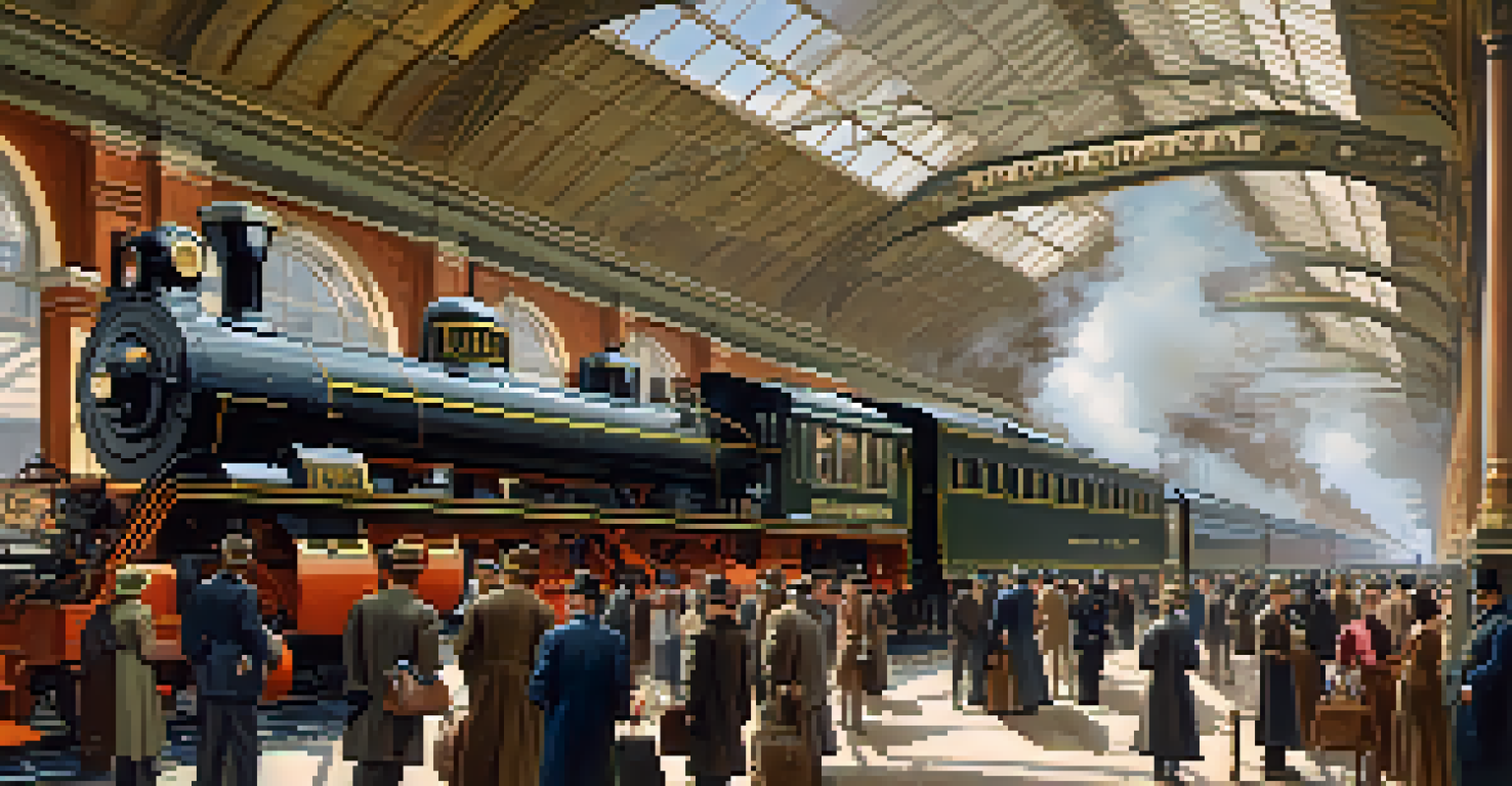The Rise and Fall of the Pennsylvania Railroad Company

The Birth of Pennsylvania Railroad: A Game Changer
Founded in 1846, the Pennsylvania Railroad (PRR) quickly became a vital part of America's transportation landscape. With its innovative approach to rail travel and freight services, it connected major cities and facilitated commerce like never before. Imagine a spider's web, with each strand forming links between bustling hubs of trade and industry.
The railroads are a great example of how our economy works, and how competition and innovation can drive progress.
The PRR's early success was driven by its strategic routes, which allowed it to dominate the transportation of coal, iron, and goods. This not only fueled the industrial growth of Pennsylvania but also set a standard for railroads nationwide. As more people and businesses relied on its services, the company expanded rapidly, leaving a significant mark on American history.
By the late 1800s, the Pennsylvania Railroad was the largest railroad in the world, boasting a sprawling network of tracks and stations. It was a symbol of progress and innovation, making rail travel accessible to the masses. However, this rapid growth came with its own set of challenges, foreshadowing the complexities that lay ahead.
Innovations that Shaped Rail Industry Standards
The Pennsylvania Railroad was a pioneer in introducing various technological advancements that transformed the rail industry. From the adoption of the first steel rails to the implementation of air brakes, PRR set benchmarks that other companies would strive to match. These innovations significantly improved safety and efficiency, making rail travel more reliable.

Additionally, the PRR embraced the concept of the 'block system' for train signaling, which helped prevent collisions and improved the flow of trains. This system allowed for more precise scheduling and increased the overall capacity of the railroad. By prioritizing safety and efficiency, the Pennsylvania Railroad not only enhanced its operations but also inspired confidence among its passengers.
Pennsylvania Railroad's Early Success
The Pennsylvania Railroad revolutionized transportation in the 19th century, connecting major cities and fueling industrial growth.
These innovations were crucial during the industrial boom of the early 20th century, as they enabled the PRR to handle an increasing volume of freight and passenger traffic. The company’s commitment to progress established it as a leader in the transportation sector, showcasing how innovation could drive growth and success.
The Golden Era: Pennsylvania Railroad's Peak Years
The early 20th century marked the golden era of the Pennsylvania Railroad, as it reached the height of its influence and profitability. With a vast network of over 10,000 miles of track, PRR played a central role in connecting the northeastern U.S. to the Midwest, facilitating trade and travel during a booming economy. During this time, the railroad was not just a means of transport; it was an integral part of American culture.
Adaptability is about the powerful difference between adapting to cope and adapting to thrive.
The company also invested heavily in luxurious passenger services, introducing ornate train cars and high-end amenities. This commitment to passenger experience attracted wealthy travelers and set a new standard for rail travel. Imagine stepping into a PRR train, where elegance met convenience, creating a memorable journey for all who boarded.
However, as the golden age continued, signs of impending challenges began to emerge. While the PRR thrived, competition from emerging transportation modes, such as automobiles and airplanes, started to reshape the landscape of travel and freight.
The Impact of Competition and Changing Times
As the mid-20th century approached, the Pennsylvania Railroad faced fierce competition from the rise of the automobile and the growth of commercial airlines. These new transportation methods offered convenience and speed, gradually pulling passengers away from trains. The shift in consumer preference forced PRR to rethink its strategies and adapt to a rapidly changing market.
In response, the Pennsylvania Railroad attempted to modernize its services and infrastructure, but the costs of maintaining such a vast network proved burdensome. While some initiatives were successful, the company struggled to keep pace with the evolving transportation landscape. It was akin to trying to catch a train that had already left the station.
Challenges from New Transportation
As automobiles and airlines gained popularity, the Pennsylvania Railroad struggled to adapt, leading to declining ridership and financial strain.
This competition led to declining ridership and freight traffic, causing significant financial strain on the company. As operational costs rose and revenues dipped, the Pennsylvania Railroad found itself at a crossroads, needing to make critical decisions about its future.
Financial Troubles: The Beginning of the End
By the 1960s, the financial troubles of the Pennsylvania Railroad were becoming increasingly evident. Mounting debt, coupled with declining revenue, led to operational cutbacks and layoffs. The once-mighty railroad found itself struggling to maintain its service quality while also facing mounting pressure from stockholders and creditors.
In 1962, the PRR's financial situation worsened to the point where it had to seek public funding to stay afloat. This reliance on government support highlighted the severity of its struggles and marked a significant shift in its operational philosophy. It was a wake-up call that the railroad industry was undergoing a transformation, and PRR needed to adapt or risk extinction.
Despite attempts to restructure and revitalize the company, the Pennsylvania Railroad could not overcome its challenges alone. The culmination of these financial woes eventually led the company to merge with the New York Central Railroad in 1968, creating a new entity in hopes of revitalizing the struggling industry.
The Merger: A New Chapter with New Challenges
The merger between the Pennsylvania Railroad and the New York Central Railroad was seen as a potential lifeline for both companies. Formed as Penn Central Transportation Company, the hope was that combining resources and routes would create a stronger, more competitive entity in the rail industry. However, this new chapter came with its own set of challenges, as the integration proved to be more complicated than anticipated.
As Penn Central struggled to integrate the two companies, operational inefficiencies began to surface. The ambitious merger, which was intended to revitalize both railroads, resulted in significant financial losses. It quickly became apparent that the new company was not equipped to handle the complexities of merging two large operations.
Legacy and Lessons of PRR
Despite its decline, the Pennsylvania Railroad's innovations and history offer valuable lessons about the importance of adaptability in business.
In 1970, just two years after the merger, Penn Central filed for bankruptcy, marking one of the largest bankruptcies in U.S. history at that time. The fallout from this failure sent shockwaves through the railroad industry, demonstrating the fragility of even the most established companies when faced with economic and operational challenges.
Legacy of the Pennsylvania Railroad: Lessons Learned
Despite its decline, the legacy of the Pennsylvania Railroad continues to resonate in today’s transportation industry. The innovations and standards it established laid the groundwork for modern rail travel and freight services. Its story serves as a reminder of how even the most powerful entities can face downfall when they fail to adapt to changing times.
Moreover, the PRR's history highlights the importance of innovation and customer experience in maintaining relevance in a competitive market. As we look at today's transportation landscape, the lessons learned from PRR's rise and fall can guide current and future companies in navigating their own challenges.

Ultimately, the Pennsylvania Railroad Company remains a significant chapter in the story of American transportation. Its journey reflects the dynamic nature of industry, reminding us that success is often accompanied by challenges that require foresight, flexibility, and the willingness to evolve.